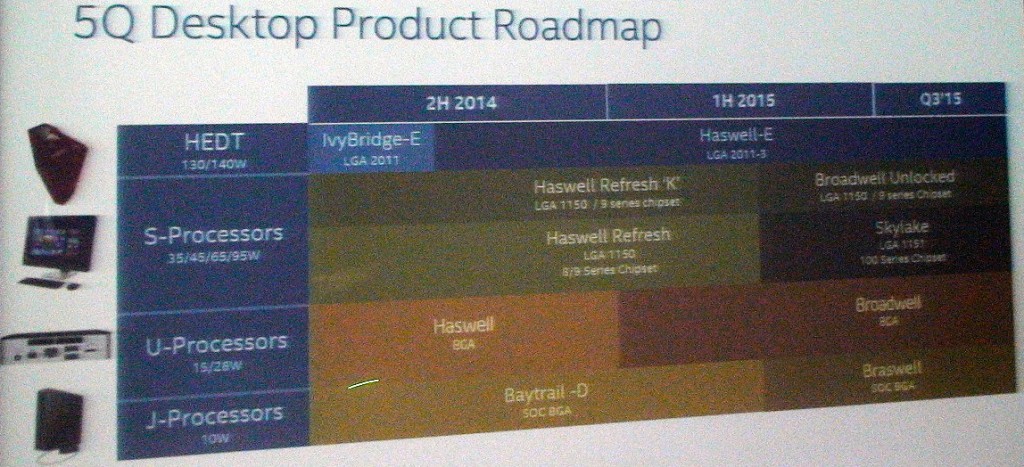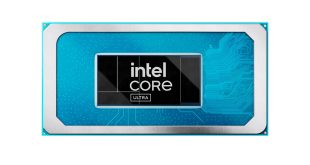Intel Corp. has pulled-in introduction of its next-generation mainstream enthusiast-class microprocessors code-named “Broadwell-Unlocked” and “Broadwell-K” by several months, according to a slide the chip giant allegedly demonstrated to its partners earlier this week. The slide also confirms that Intel plans to introduce its code-named “Skylake-S” microprocessors for desktops already in the first half of next year.
Intel’s new Core i7 and Core i5 “Broadwell Unlocked” microprocessors with unlocked multipliers in LGA1150 packaging compatible with existing platforms based on Intel 9-series chipsets are to be introduced already in the second quarter of 2015, according to a slide that Intel showed at its technology conference for partners in Athens, Greece. Slides from the presentation were published by a member of AnandTech forums on Wednesday.
Previously it was expected that Intel’s high-performance desktop chips based on the “Broadwell” micro-architecture would be launched in July, August or September, 2015. Apparently, the company has managed to pull-in introduction of its new chips by several months.
The most advanced versions of Intel “Broadwell” microprocessors for client PCs will feature up to four x86 cores with the Hyper-Threading technology, Iris Pro graphics processors with up to 48 execution units, up to 8MB of last level cache (LLC), up to 128MB of high-speed eDRAM off-die cache, dual-channel DDR3 memory controllers and so on. The “Broadwell” family of central processing units is made using 14nm fabrication process.
In a bid to offer performance improvement over existing Core i7-4790K “Devil’s Canyon” microprocessor (four cores with HT, 4GHz, 8MB LLC), the alleged Core i7-5770K “Broadwell Unlocked” will have to run at a frequency that is higher than 4GHz.
The slide from Intel’s technology conference also reaffirms the company’s plans to roll-out “Skylake-S” processors for desktops in the Q2 2015. The chips will feature LGA1151 packaging and will rely on platforms based on Intel 100-series chipsets. The co-existence of the “Broadwell Unlocked” and “Skylake-S” products on the market will likely cause a lot of confusion among end-users. Intel’s “Skylake-S” platforms will offer an all-new CPU micro-architecture (with AVX 3.2, 512-bit extensions and so on), native SATA Express support (which means they will support advanced SSDs with 2TB/s or even 4TB/s read speeds), Thunderbolt 3.0 (40Gb/s) and DDR4 memory option, but will not offer overclockability (since Intel has no plans to release Skylake processors with unlocked multiplier in Q2 2015). By contrast, Intel’s “Haswell-K” and “Broadwell Unlocked” will offer overclockability, but will not feature native SATA Express support and will continue to rely on DDR3 memory.
Intel did not comment on the news-story.
Discuss on our Facebook page, HERE.
KitGuru Says: The fact that Intel decided to pull-in introduction of the “Broadwell Unlocked” processors may indicate that the company has finally managed to solve its yield issues with the 14nm fabrication process. While this is a good news, it also means that there is going to be a mess on the market of desktop computer platforms next year.
 KitGuru KitGuru.net – Tech News | Hardware News | Hardware Reviews | IOS | Mobile | Gaming | Graphics Cards
KitGuru KitGuru.net – Tech News | Hardware News | Hardware Reviews | IOS | Mobile | Gaming | Graphics Cards




When you are the undisputed top predator of your niche market like Intel is, you don’t do that kind of move unless you are under some sort of pressure. And that pressure is certainly not coming from AMD. I would guess that global sales might have slow down too much for Intel taste to force their hand to release this ahead of time.
That’s what happen when technology becomes ubiquitous and reach the “good enough” level. We used to have 100% performance improvement within the same platform from say a Pentium 3 500Mhz and Pentium 3 1Gz. Now we are lucky to get a few percentage points.
Why someone who bought a Sandy Bridge 2500K, easily overclocked to 4.5Ghz, -4 YEARS AGO- would need to upgrade? Especially considering the artificial market segmentation policy Intel is pushing where you need to replace the motherboard every 2 new processors… Shelling out 250-300$ on new CPU + 200-250$ on a motherboard, when your 4 years old rig is STILL indecently fast makes no sense at all.
For what anyway? 5 more FPS in your games? Video conversion 5 minutes faster? Zip compression 7.2 secondes faster? Is that worth 450-550$? Seriously? And now, you even need to upgrade your RAM to DDR4, and again, benchmarks shows little to no improvment in games and regular applications. That’s another 300$ for a decent 16GB kit…
Margin are slim to non existent, upgrade cycles are now commonly stretched to well over 5 years and add the recession on top so people are spending less, it’s not surprising Intel want to shake things up. I wouldn’t be surprised either that in a few years, Intel do something similar what IBM is doing now and let go of entire market segment becoming non profitable and concentrate into vertical markets such has business, governmental, military, academic and scientific. The day any Joe Blow company can manufacture a “good enought” CPU for 95%+ of end user’s scenarios, for only a few buck, is near.
Depends on individuals opinion. As people say time is precious. Money can be earned back but time?…
So it only about 20% better than Haswell? Hmm why does people upgrade their CPU every year?…
Um, 2-4TB/s reads? Someone fire the editor. GB/s Current read speeds max out at 550MB/s
Sandy Bridge iGPU is useless for OpenCL for one thing. Also, Broadwell’s iGPU gets unified memory, making it blazingly fast compared to the Haswell iGPU while supporting OpenCL 1.2, OpenGL 4.4 (I think), DX 11.2 in native hardware, and you get SSE 4. If software pushed hardware anymore on the CPU side, AMD would be dead, not an FX chip left in the market.
Every year is stupid, and 3 years is still too soon, but 4 is fair. I made my old Q9550 last until the 4960X. I refuse to buy again until Cannonlake at the very earliest. Maybe if Zen convinces me it’s still an upgrade over Ivybridge while also being a strong APU, I can dump Intel and Nvidia in one go.
per drive yes… what if you have a few drives.. don’t want the processor slowing that down do we? 🙂
per drive yes… what if you have a few drives.. don’t want the processor slowing that down do we? 🙂
well said.. there is a very VERY small percentage of people who would actually have a need over greed reason to upgrade to this from an already good processor. Some people just have a lot more money than sense.
well said.. there is a very VERY small percentage of people who would actually have a need over greed reason to upgrade to this from an already good processor. Some people just have a lot more money than sense.
Intel has no plans to release Skylake processors with unlocked multiplier, Intel’s “Haswell-K” and “Broadwell Unlocked” will offer overclockability.
I guest not when the highest clock I believe is 2.8Ghz could be wrong but pretty sure I read something like this a few months ago. Broadwell Unlocked By that do you mean a extra 100Mhz for $400 dollars, if so then yeah great Unlocked. Truly though no one wants a SoC for a desktop.
PhoneyVirus
https://twitter.com/PhoneyVirus
https://phoneyvirus.wordpress.com/
so 4960x 8core cpu?
or w8 for skylake?
not going to upgrade for 6 years
also 2×980?
or w8 for better?
going to have the money in mid 2015
think from perfomance perpective build with pci-e ssd,144hz monitor,productivity plus gaming
Wait for better, and if the better isn’t as good as you thought, you can go with the 980 and 4960X. The rates will also be much lower…
Without an 8x PCIE 3.0 SSD with controller to match, that sort of speed is a pipe dream.
I agree, I bought into the hype and upgraded over a Sandy Bridge. Its all so easy to read about potential performance gains like “effectively doubling available memory pathways … yada yada.” . I forked out 600 quid for a new setup when my old one was perfectly functional. For me the time is money argument doesn’t apply to modern computing where hundreds of pounds buys you microseconds on application startup times. Lets face it, there may be the odd few people of whom the latest tech actually makes a real difference to productivity output, but for the VAST majority of us its just an outlet for an obsessive materialistic lifestyle.
Well, since we’re at a point where the CPU will rarely ever bottleneck a GPU in most games, that might be somewhat true there. Significant performance improvements HAVE been made since the 2500k though. Those X99 chips will render video many times faster than your 2500k will, for instance.
Or you could save some money and just go 5820k now.
Most of the more radical improvements comes from new extensions such as AVX2, extensions that take many years to reach market critical mass adoption as developers do not integrate them in their code fast enough. I stretched my good old Athlon 1700 XP 1.45GHz overclocked to 2.4Ghz for many years before I hit the SSE2 requirement wall and finally upgraded to my current 2500K @ 4.7Ghz.
With 16GB of 1600Mhz RAM @ 8-8-8-21-1T and 2XM4 SSD in RAID0 pushing well over 900MB/s, I won’t upgrade that PC for a long, long, LONG time. The only thnig that will eventually change is my secondary strorage from 2 to 4TB and my 660 GTX @ 1.3Ghz in 2-3 GPU generations. This GPU drives 3 X 1680X1050 monitors like a charm and play all game to high or very high at that resolution or 1600X900 or even 1280X800 if necessary. Far Cry 3 at high + some options even at very high @ 1680X1050 and I’m getting a good constant 40FPS and above. BF4 is basically locked at 60FPS, except a few very intense scene that dips into the mid 40s.
The other improvements worth mentioning is the iGPU including the silicone that make up quick sync, which is useless for me because I use a dedicated GPU. CPU core for CPU core, Cinebench from Maxon do not render 3D scene on X99 “many times faster” than a 2500K. It’s only when you get to the multi threaded part that it can show it’s might. Bedside, the comparison is not entirely fair: The X99 is semi professional workstation, my Z68 motherboard is not. The Haswell-E i7-5960X is a 8 core, 16 threads $1000 monster… http://www.anandtech.com/show/8426/the-intel-haswell-e-cpu-review-core-i7-5960x-i7-5930k-i7-5820k-tested/5 . A more adequate comparison would be a 2700K VS a 4770K. Then you’ll see than unless the application heavily use newer extension, the actual gain core for core and clock for clock in not very high.
True. but, whats with the tone? It is what it is, I’d prefer progress not to slow simply because we dont “need it”
But with broadwell we are talking about pcie 4.0 so a 4x would be enough, right now we have motherboards with m.2 pcie 3.0 4x. So that doesn’t sound that crazy…
http://www.cpu-world.com/Compare/582/Intel_Core_i7_i7-2700K_vs_Intel_Core_i7_i7-4770K.html speeds are about 10% faster but the power consumption is much less. unlike some i dislike needing a whole power station to run my computer
4yrs is way to long to leave off upgrading. i too have a q9550, and it was outdated two years after my purchase. that cpu is rubbish for video editing
you get more than 100mhz for unlocked cpus, more like 700-800
If my Dad can make a Q6600 last 7.5 years, you easily could have done the same for the 9550 with a small investment in overclocking.
The 4790k will easily last him the next decade.
What does it means that Broadwell unlocked will not feature native SATA Express support???
In fact I have sata express port on my motherboard and my motherboard completely supports it, i.e Msi Z97 Gaming 5.